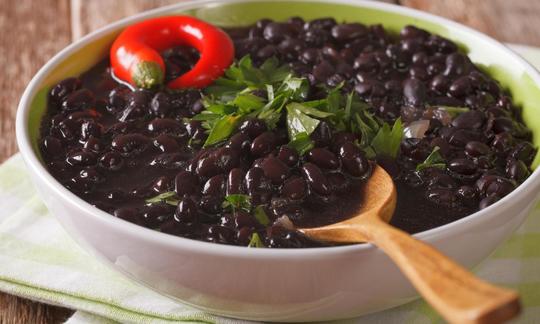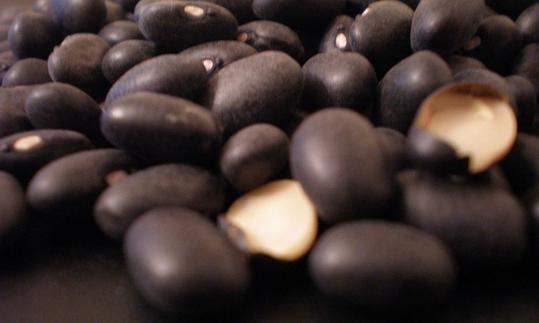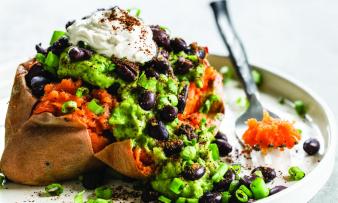Table of contents
Cooked black beans are a variety of the common bean ( Phaseolus vulgaris ) and contain lots of fibre and protein.
Use in the kitchen
The beans are narrow, round and have a shiny, black skin. Compared to other beans, they are waxy and taste spicy and nutty. Because they contain a lot of fiber and protein, they are a valuable source of protein in vegetarian and vegan dishes. Black beans are particularly popular in Latin America and are part of many national dishes such as feijoada, moros y cristianos and gallo pinto.
The black beans take a long time to cook (more on this under "Your own preparation"). It is therefore worth cooking the beans separately and then adding them to the various dishes. They go well in stews, casseroles and mixed vegetables, for example with tomatoes , yellow bell peppers , chili peppers , corn , spinach or chard . The beans are traditionally eaten with long grain rice or corn semolina (polenta). Cooled, cooked black beans go well in raw salads or you can use them to make a dip or bean puree.
If you buy beans, rinse and drain them well before heating to remove any preservatives. Beans from a jar are preferable to those from a can.
Your own preparation
Soak the dried black beans overnight in three times the amount of water, or for 8-12 hours. This reduces the phytic acid in the beans. Phytic acid binds minerals in the human body, so that they are no longer available to the organism. More on this here: " Phytic acid or phytate and soaking or sprouting ". This also reduces the cooking time and can improve the digestibility of the beans.
Pour away the soaking water and rinse the beans well. Put the beans in a pot and fill with water until they are generously covered. Simmer on a medium heat until the desired firmness is reached. After an hour, check the beans for firmness. Black beans need up to 2 hours to become soft. In a pressure cooker, the cooking time for the beans is usually reduced to 40-60 minutes. To cook the beans faster, you can add a teaspoon of baking soda to the soaking or cooking water. The baking soda softens the hard water and the beans cook faster. Sometimes you will also find information that this makes the beans more digestible and causes less flatulence. Acids such as tomato sauce, vinegar and lemon juice should be added at the very end. Contrary to previous assumptions, salt shortens the cooking time because it softens the cell walls of the beans (and other legumes such as lentils and chickpeas). 18
Vegan recipe for black beans with rice (gallo pinto)
Ingredients (for 4 people): 400 g long grain rice , 150 g black beans, 1 red bell pepper , 1 onion , 2 cloves of garlic , 1 tbsp rapeseed oil , 1 tsp cumin , 1 tsp hot paprika powder , salt ,black pepper , 3 tbsp Lizano salsa sauce or alternatively vegan Worcestershire sauce, bunch of fresh coriander leaves.
Preparation: Cook the rice and black beans separately (see preparation of long grain rice and preparation of black beans below). Wash the bell peppers and cut into small cubes. Peel and finely chop the onion and garlic cloves. Sauté the bell peppers, onions and garlic in a large frying pan with rapeseed oil. Add the cooked beans, cumin, paprika powder and Lizano Salsa Sauce or Worcestershire Sauce. Season with salt and pepper. Simmer for 2-3 minutes, then add the cooked rice and mix everything well and heat over a medium heat until the rice is warm. Serve the rice dish on plates and garnish with fresh coriander leaves.
Vegan recipes with cooked black beans can be found under the note: " Recipes that have the most of this ingredient ".
| Not only vegans or vegetarians should read this: Vegans often eat unhealthily. Avoidable nutritional mistakes . |
Purchasing - Storage
Black beans can be bought dried or cooked in jars or tins, sometimes even in organic quality. They are available all year round . They can sometimes be bought in large supermarket chains such as Coop , Migros , Spar , Rewe , Edeka or Hofer . Other supermarkets such as Aldi , Denner , Volg , Lidl and Billa rarely have them on offer. Black beans are also available in organic supermarkets such as Denn's Biomarkt or Alnatura or in health food stores.
The availability of black beans in the supermarkets mentioned varies depending on the size of the store, catchment area, etc. If you are interested, click on our recorded food prices for the DA-CH countries (above under the ingredient image). There you will find current prices from various supermarkets and their price development.
Storage tips
Cooked black beans can be stored in an airtight container in the refrigerator for one to two days. 15
Ingredients - Nutritional values - Calories
Cooked black beans (organic) contain 132 kcal per 100 g. They are very rich in fiber with 8.7 g/100g of dietary fiber. 100 g of beans contain 8.9 g of protein and 24 g of carbohydrates. The fat content is low at 0.54 g/100g. 1
Black beans are rich in folate (folic acid) with 149 µg/100g. This corresponds to 75% of the daily requirement. Frozen spinach (145 µg/100g), kale (141 µg/100g) and endive (142 µg/100g) have similar values. 1
The protein-rich beans contain all eight essential amino acids. Tryptophan and threonine are abundant, with 0.10 g and 0.37 g per 100 g of black beans respectively. Isoleucine , lysine , phenylalanine , leucine , valine and methionine are also well represented. 1
The trace element manganese is contained at 0.44 mg per 100 g. This corresponds to 22% of the daily requirement. Chickpeas are very rich in manganese at 2 mg/100g. 1
It also contains thiamine (vitamin B1) with 0.24 mg/100g, which corresponds to 22% of the daily requirement. Green peas (0.27 mg/100g), sweet chestnuts and chestnuts (0.24 mg/100g) have similar values. 1
The complete ingredients of cooked black beans, the coverage of the daily requirement and comparison values with other ingredients can be found in our nutrient tables. In the article Nutrients explained you will get a detailed insight into the topic.
Health Benefits
Beans are rich in phytochemicals that have anti-inflammatory and antioxidant effects. The levels of these are strongly correlated with the color of the pod, with black beans being characterized by higher levels of polyphenols, anthocyanins, condensed tannins and flavonoids. 14 Black beans contain many phenolic compounds. 10,11 Studies show that extracts from them support the body's immune system in recognizing and destroying cancer cells and weaken the formation of metastases. 10,12 However, a higher concentration of phenolic compounds was usually used than can be found in food. 12
Black beans also contain plenty of folic acid. This is involved in important metabolic reactions and is important for the development of the central nervous system. A sufficient supply of folic acid is particularly important for women who want to have children in order to prevent birth defects. 19
Dangers - Intolerances - Side effects
Black beans should always be soaked and then cooked or germinated due to the anti-nutrients they contain. You can find out more about this under the ingredient Black beans, ripe seeds, raw .
Eating black beans can lead to increased gas formation in the large intestine and thus to bloating and flatulence. This is due to the polysaccharides contained in the beans (oligosaccharides), which ferment the intestinal bacteria and thereby secrete gases. 2 To reduce bloating, it is worth soaking the raw beans overnight before cooking and throwing away the soaking water. There is also some advice that adding baking soda makes the beans more digestible. 3 Spices such as savory , fennel seeds , anise , coriander seeds , cumin seeds and caraway seeds aid digestion and relax the intestinal muscles, which is why they can reduce bloating.
Ecological footprint - animal welfare
Despite extensive research, we were unable to find any specific data on the ecological footprint in terms of CO 2 emissions and water consumption for the production of cooked black beans. The following information therefore refers to pulses such as beans, chickpeas , soybeans , lentils and peas. Due to their high protein content and fiber, these are considered healthy plant-based protein sources and have a better environmental impact than milk and meat products. Their ecological footprint is smaller because they require less arable land and water and have fewer CO 2 emissions. It is therefore more environmentally and climate-friendly to eat plant-based proteins in the form of pulses than meat and milk products. In addition, many calories are lost during meat and milk production because more plant calories have to be fed to the animals than are ultimately produced as animal calories. 6,7,17
The largest producer and consumer of black beans is Brazil, but they are grown in countries all over the world. China, Mexico, the USA, India and even individual regions in Germany grow this legume, among others. 20,21 Ideally, when shopping, you should look for regional, organically grown products, because organic farming does not use synthetic pesticides. In conventional farming, on the other hand, large quantities of herbicides (such as glyphosate) are used when growing legumes, and not just to control weeds. Desiccation, a practice to speed up the harvest, involves deliberately killing the crop using herbicides. This dries out the plant and the crop ripens more quickly. This is used primarily in countries where the growing season is too short, such as Canada, or simply as a time-saving measure. 22 Accordingly, there may also be an increased concentration of this agent in the end product, especially in legumes or grains. 23
You can buy ready-cooked black beans in shops either in jars or tins. The latter are usually made of aluminum or tinplate. The production of aluminum requires a lot of energy and the raw material bauxite, which has to be mined over large areas (including rainforests). In addition, aluminum production produces an intermediate product that is toxic to the environment, so-called red mud (contains iron and titanium oxides). If disposed of improperly, this causes serious environmental problems. 24 Aluminum can be recycled after use, but this process also requires a lot of energy. 25 However, the same applies to the production and recycling of glass. The weight during transport also has a negative impact. 26 Ideally, you should buy black beans raw and prepare them yourself.
Worldwide occurrence - cultivation
The common bean ( Phaseolus vulgaris ) originally comes from Central America and the Andean region of South America. For a long time it was assumed that there were two centers of domestication, but new research shows that the common bean was probably first domesticated in Mexico and later planted in the Andean regions. 4 In the 16th century, common beans were introduced to Europe. Varieties from Central and South America were planted. Over the centuries, Europe developed its own varieties through hybridization. 5
In international trade, no distinction is made between the individual varieties. According to FAOSTAT , 27.4 million tons of dried beans were produced worldwide in 2020. 8 Brazil is the largest producer and consumer of black beans with a product volume of 438,240 tons. 9
For information on cultivation and harvesting, see the article Black beans, mature seeds, raw .
Industrial processing
Black beans can be bought in cans or jars. The beans come to the processing plants, usually as dry products. First they are soaked in water overnight. Then they are briefly blanched at 80 to 85 °C. After filling them into the cans, they are filled with infusion liquid. This often contains salt and spices, sometimes also modified starch. The latter prevents the kidney beans from bursting during sterilization. After the cans are hermetically sealed, they are heated in special pressure vessels at overpressure to 115 to 140 °C. They are then quickly cooled to 20 °C so that the beans do not overcook and become mushy. 16
Further information
Black beans are a variant of the common bean ( Phaseolus vulgaris ). This belongs to the subfamily Faboideae. The pods of the common bean ( Phaseolus vulgaris ) can be flat or round in cross-section, and can be marbled in different colors such as green, yellow, purple or black. The seeds of the common bean also have different colors and shapes.
Alternative names
Black beans are called Black Turtle Beans in English-speaking countries, not Black Beans. In Spanish they are called Frjoles negros and in Portuguese Feijão Preto, which translates to black beans.











Comments